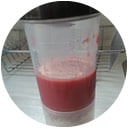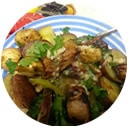One of the best articles we have read regarding how to best maximise recovery is from the guys at 180nutrition. For full article, click here. Below, we provide you a summary of what could be the most important aspect: Nutrition.
The article points out that it is important to remember that no one size fits all. There are those who want to gain weight, those who want to lose weight, those whose training demands may be greater than others, genetics, age and so forth. However if you are not implementing any of those guidelines and need help to start, the below are totally worth putting in practice.
Post recovery can be dissected into four categories (in no particular order):
- Nutrition
- Supplements
- Rest & Repair
- Mindset
This blog post will cover part 1 – Nutrition, the long term approach to nutrition for better health, post workout nutrition (short term), what should be avoided, and concludes with example of food diaries of Chad Mackay and Ruth Anderson.
‘You don’t get fitter, faster & stronger from working out… You get fitter, faster & stronger from RECOVERING from working out.’ – Mark Sisson, Paleo & Primal Expert [Mark’s Daily Apple]
- NUTRITION
‘I can eat whatever I want because I do CrossFit.’
Whilst this is OK every now and then, in the long run we would not recommend you going full board after a workout. Especially if your goals are weigh loss and health/ maintenance.
In order to provide the body with the best chance of recovery, we need to supply it with the right raw materials. Exercise is a form of good stress on the body – it shocks our body into becoming more resilient, creates stronger muscles, is good for our bones and also beneficial for a myriad of biological processes like enhanced metabolism for example. However, once we have finished stressing our body with a workout we want to concentrate on minimising the stress as long-term stress creates something that we really want to avoid. That is inflammation. Chronic inflammation, in this case, is a low-grade irritant which just keeps hammering away at you slowly but surely. And this provokes a whole lot of immune responses right across the body. And chronic inflammation is related to our diet.
The combination of sugar, refined carbohydrates, and polyunsaturated oils is the root cause of inflammation. Sugar will make you hungry, processed carbohydrates will make you fat, and the polyunsaturated oils like the margarine will give you an inflamed mini combination that creates modern disease.
LONG-TERM NUTRITIONAL APPROACH
The long-term recovery is a seven days a week approach. It doesn’t stop on Friday night and begin Monday morning. How you fuel yourself in the long-term is what’s going to set up your foundation and ability to recover with the gains you are after. Removing the inflammatory foods out of your diet as best as possible is a great place to start. Eating nutrient dense whole foods every day is crucial! One of the biggest downfalls is that people are unprepared by not allowing enough time to food prep. They get caught out and snack on convenient/ fast foods.
With a little preparation, you can smash the long-term nutritional approach. Incorporating whole foods such as eggs, nuts, fruit, veggies and protein will set you up to conquer your goals. If you’re short on time but still want to eliminate poor quality food from your diet then whole food shakes and smoothies make a great option. A liquid meal is quick and easy and will allow you to replace meals (if that’s your goal) or squeeze in extra meals with very little prep. Ensure that you are eating smarter carbs that deeply nourish your body, ie. sweet potatoes, fruit, starchy/green leafy vegetables over breads, pastas and convenience foods. Play with the amount a little and see how you feel, perform and recover.
SHORT TERM NUTRITIONAL APPROACH (Post Recovery)
You’ve just finished a workout and pushed your body to the limit, so now what? There are many schools of thought when it comes to the post recovery window. If you are not implementing the long-term nutritional approach mentioned above, the short-term recovery windows will produce far less benefits. The main results will come from what you eat each day, not just what you eat after your WOD. If you’ve just smashed yourself in the workout and you’re wiped out on the floor, it usually means your glycogen stores will be depleted from your muscles. This is your best window for carbohydrate to help replenish muscle recovery. It could be as simple as a banana and protein smoothie which is easy to digest. The general rule of thumb though is to consume something within 30 minutes of your workout (especially if it’s really intense).
A well balanced carb/protein/fat meal would be ideal. This could be as simple as a big bowl of colourful salad with 1/2 a chopped sweet potato (non-inflammatory carbs), diced chicken (protein) smothered in olive oil (fat). Many people also have a post-workout snack to tie them over until their main meal.
Here are some examples of the do’s and don’ts of what post-recovery snack/food looks like.
The Don’ts
- High street protein bar (or protein shake) with cheap artificial ingredients, chemical sweeteners/flavourings, sugars and vegetable oils
- Carbohydrate gels and goos
- Fancy flavoured fluro sports drink (usually high in sugar or chemical sweeneners)
The Do’s
- Banana (whole food carbohydrate source)
- 1-2 boiled eggs (quality whole food fat + protein)
- Chemical free protein shake/smoothie
- Water, pinch of himalayan rock salt & 1/2 a lemon (natures sports drink)
TIPS: When you eat carbohydrate you elevate blood sugar and your body produces the hormone ‘insulin’ to regulate your blood sugars. Whilst the body is producing insulin you CAN NOT BURN BODY FAT. So if your long term plan is to lose some body fat, it could well be worth delaying your post workout recovery meal for a minimum of 30 minutes as you will be delaying the insulin response, allowing body fat stores to be used. This is something you will have to self-experiment with a little, as a lot will depend on the intensity of the WOD and how you feel after. If your muscles begin to shake after your workout, you’ve depleted your glycogen stores and it’s time to refuel yourself.
Sports Drinks
A simple and effective rehydration strategy can be as simple as water, a pinch of himalayan salt and 1/2 a lemon for taste. The salt will also help with the rehydration of the cells.
What about coconut water?
Whilst natural coconut water can be bursting with magnesium, electrolytes and goodness, it’s still fairly high in sugar. Only drink this post workout after an intense session. Do not drink it all through the day if your goal is weight loss / maintenance.
Conclusion: Whatever you do, make sure you play the long-term nutritional approach first by removing the inflammatory foods and eating adequate amount of whole foods every day. Then worry about your post recovery window.
EXAMPLE OF CHAD MACKAY FOOD DIARY
Chad Mackay is one of the finest athletes here in Australia.
You can’t out train a bad diet – Chad will be the first to agree with this. So whether you are looking to lift your training to the next level, shed a few kilos or get more bang for your buck with your own exercise regime, there are great clues here to what one should and should not be eating to feel awesome and be at your best fighting weight!
You will not find any sugar, gluten or carb loading grains here.
CHAD MACKAY FOOD DIARY
05:25am
Upon waking I will have:
- 2 x 50g scoops of 180 Protein Superfood with a double shot of coffee with a dash of full cream milk
- 15 almonds
- 1 banana
- 1L water
09:00am
1 hour pre-workout:
- 1 boiled egg
- 3 almonds
- 1/8 of an apple
11:45am
10 minutes post-workout
- 100gm grilled chicken thigh
- 2 x cucumbers
- 1 x red capsicum
- 7/8 of an apple
- 12 almonds
- 1L water
14:00
1 hour pre-workout
- 1/2 x 50g scoop of 180 Protein Superfood
- 1/4 banana
- 3 almonds
16:30
10 minutes post-workout
- 150gm of grilled chicken thigh
- 2 x cucumbers
- 1 x red capsicum
- 3/4 of a banana
- 12 almonds
- 1L water
18:30
Dinner
- 150gm red meat
- Grilled vegetables seasoned with olive oil and pepper
- 2 heads of broccoli
- 1 bunch of asparagus
- 1/4 of a cauliflower
- 1 zucchini
- 1L water
21:00
Snack
- 50gm Brookfarm nut mix
- 50gm Greek yogurt
- 50gm blueberries
RUTH ANDERSON FOOD DIARY
Ruth is a three-time CrossFit Games competitior who trains 3 days on, then one day off. Each day consists of roughly 3hr 30min of training which can be split into two separate sessions… Just depends on my regime at the time.
Breakfast
Black coffee with coconut oil added every day first thing! Tastes great helps me get those essential fatty acids.
- 3 eggs cooked in 1 tsp of olive or macadamia oil. Add 2 tbs coconut oil and 1/2 scoop of 180 protein powder on top and with a lil’ water. Weird but this is what I have. Again more essential fats, protein & whole food.
Mid Morning Snack
- Avocado and a handful of sunflower seeds. (More essential fatty-acids)
Lunch

- 1 can drained tuna, celery coleslaw & some mayo, 2 x tsp of olive oil and a bunch of veggies, (this pic was celery from the garden). The veggies will vary from broccoli to other leafy salads and cabbage.
Simply squeezed banana berry smoothie or spirulina banana smoothie (250mls & carbs) plus 200mls water then add in 2 x 50g scoops of 180 protein powder. I mix this post WOD add another glass of water and have my fish oil at the same time. This is a delicious treat for getting through 2.5 hours of training. I have one of these a day after my crossfit training (2.5 hours or so, so yes Im allowing myself some sugar, and Im ok with this), after lifting for an hour at night I just have my chicken and sweet potato (carbs).
7 ounces of chicken cooked with moroccan spice, 1 cup kumara on a bed of broccoli or cabbage. It is my standard dinner, and I make slight variations by changing spices and the types of green veggies, but I find chicken and sweet potato seems to make me feel best, and train the hardest.
References: 180nutrition http://180nutrition.com.au/



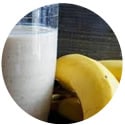
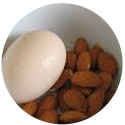
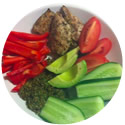
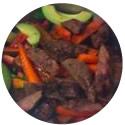
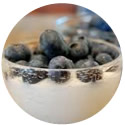
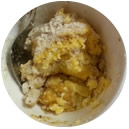 Black coffee with coconut oil added every day first thing! Tastes great helps me get those essential fatty acids.
Black coffee with coconut oil added every day first thing! Tastes great helps me get those essential fatty acids.